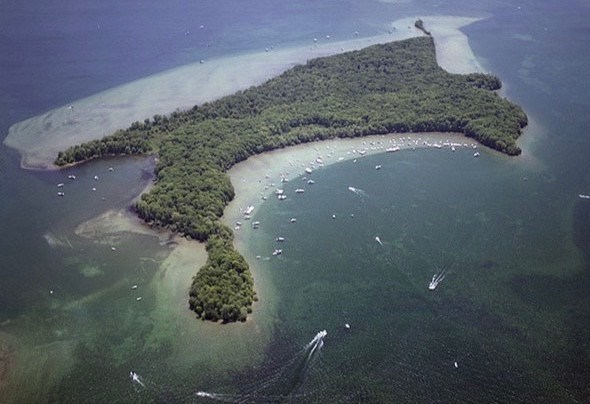Rama First Nation is cracking down on boisterous boaters and “three-day parties” near its sacred burial grounds on Chief Island.
The issue hit a “tipping point” last summer when a number of parties at Chief Island were promoted on social media channels - despite the backdrop of a global pandemic.
Those long weekend parties included staging for live performances and vendors and “attracted significantly more attendance” than previously experienced, noted a May 18 memo to the community from Rama First Nation Chief Ted Williams and Council.
The memo cited “parties that continue into the night, that produce excessive noise and rowdy partying, alcohol and drugs and waste materials left both in the water and on Chief Island for Rama to clean up.”
It’s something members in the community do not want to see repeated this summer - a message that resonated in a survey of community members.
That survey, taken in January of 2021, was to explore “member usage and concerns.” Members expressed concerns for these gatherings and the disturbance to the community, noted the memo to the community.
The survey results prompted strategic planning meetings which included chief and council, in addition to representatives from the lands department, lands committee, Rama Police, communications, bylaw, Ojibway Bay Marina, the community consultation officer, information systems and other staff to “collaborate on ideas for both protecting the island and discouraging boaters.”
As a result, on the eve of the long weekend, Rama has introduced a number of measures meant to curtail the gathering of boaters in the shallow waters adjacent to Chief Island.
Some of the measures in place for the long weekend include:
- Buoys along the shoreline to both designate a swimming area (for members) and prevent boat mooring;
- A heightened police and bylaw presence enforcing boating infractions and COVID protocols;
- Signage restricting access and addressing the island’s importance to the community both on the island and in the area;
- Monitoring the island throughout the summer, particularly on long weekends with cameras recording activities in the bay;
- Staff and volunteers staying on the island and members occupying the cabins; and
- Community and public information programs.
Rama decided to “take responsibility for the safety and health of our environment, land and waters,” after reaching out to other agencies, who did not assist.
The memo notes Rama met with the Department of Fisheries and Oceans, Parks Canada, Transport Canada and Ministry of Natural Resources personnel to determine how these authorities might “assist in putting a stop to these gatherings.”
None of these authorities “have provided substantial assistance to stop or provide enforceable measures to deter these parties,” notes the memo to the community.
The memo also spells out other measures Rama has taken in recent years to “establish a strong community presence" and to “beautify the island ... as deterrents to gatherings.”
For example, three cabins were built for Rama members to use and to provide “some oversight” in the area.
In addition, areas of the island have been cleared and trails established and grave-site restoration has been undertaken to both preserve and recreate historic monuments.
Rama is also contemplating some other long-term measures. Those include:
- Investigation of enforceable Rama bylaws possibly restricting access, addressing noise and boat mooring and trespassing on the island. This would include reviewing how these challenges were addressed in similar areas in Ontario.
- Exploring the possibility of creating a breakwall of causeway restricting access and boat moorings; Rama members would have accessible docking on the island
- Clarification of historical boundaries through archival mapping
- Research into the possibility of ‘water lots’ offshore which restrict access and are enforceable by law.
- Consideration of options for a reintroduction of wild rice in the area to deter boaters and provide members with access to a traditional harvest in the area.
- Exploration of possible Conservation officer on the lake
The memo states Chief Island “is extremely important” to Rama First Nation.
According to Rama First Nation’s website, the “island is a sacred place for our people with a number of unmarked graves on the island as well as headstones. These graves include those of warriors who died in a great battle on and around the island between the Ojibwe and the Mohawks after the Huron-Wendat were decimated by war and disease. Many warriors died on the island.
“The last burial on the island was in 2002 when remains were uncovered during a construction project at the Horseshoe Valley Resort. Upon closer inspection, due to the manner in which they were buried, the remains were determined to be Ojibwe. Ceremonies were held on the island and they were buried.
“All warriors and ancestors buried on Chief Island are honoured and acknowledged during our Ceremonies on Remembrance Day and at our annual Powwow.”
For more information about this sacred island, click here to read a guest column written by local elder Jeff Monague.
